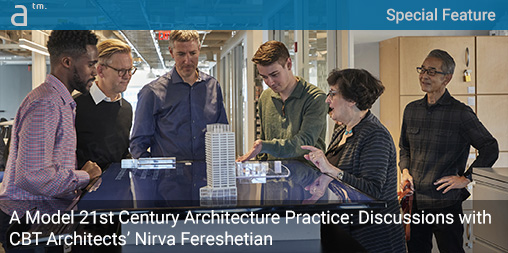Editor’s Note: This feature first ran in Architosh’s monthly emTech newsletter, Xpresso No 50. To gain early access to Architosh’s best feature content, subscribe to Xpresso now. It’s free! The article version in Xpresso 50 contains exclusive post-article analysis and commentary and an additional related small feature.
“TO BE CLEAR, I THOUGHT THE COVID EXPERIENCE was like the experiment we could not do,” says Nirva Fereshetian, Principal and CIO at CBT Architects, “This conversation about working like this was already happening at CBT before the pandemic, except that we could have never said, ‘Hey everybody, go home; we are going to test this.'”
CBT is a leading Boston-based design firm working locally, nationally, and internationally in architecture, interior design, and urban design, so working efficiently across spaces and time zones has always been an essential part of the process. The firm made it through the pandemic better than most, and today, it leverages technology to create an immersive experience for employees and clients in the office and beyond.
Improving the Employee and Client Experience Through Technology
Getting through the pandemic allowed Fereshetian and her digital practice team to use technologies they had started implementing about five years prior. The team had already been in various stages of transition to cloud technology, making remote work both feasible and manageable during the pandemic or otherwise. Fereshetian noted these technologies were always intended to help speed up processes—whether reviewing different design options quickly or monitoring construction progress—so that preparation simplified the transition to pandemic-related remote work and offered much more than a video conference experience.
This conversation about working like this was already happening at CBT before the pandemic, except that we could have never said, ‘Hey everybody, go home; we are going to test this.’
This change in work style has achieved its goals and resulted in other benefits for CBT staff. “Not being chained to our desks from eight-thirty to five-thirty has given us a tremendous opportunity to rethink how we work,” she says. It has also positively impacted work-life balance for all employees. Nobody wants to go back.”
On top of getting through the pandemic-forced changes, CBT also moved into a new physical office in the past year and a half. The new office was designed with everything the firm learned from the pandemic, plus a vision of how architectural offices of the future would need to function.
“The new office started as a place for us to experiment and have an office experience that is more than just a ‘working at your desk’ space, says Fereshetian. “The pandemic taught us the right technology works for teams, whether in an office, a conference room, or at home.”
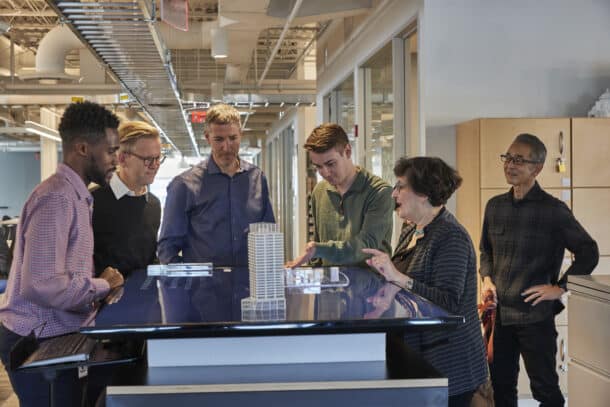
An image of CBT’s new Boston office showing colleagues, along with Nirva Fereshetian, CIO at right, on the interactive digital-to-physical 3D model screen. (click on images for larger views). (Image: CBT Architects)
To start, nobody has an assigned seat or desk. Employees can sit wherever they like on days they work in the office. Design and technical staff primarily work near their teammates, which coalesce in office areas dedicated to the firm’s practice specialties. There are various “huddle” and conference rooms of different sizes where individuals and teams can hold design and coordination meetings. These spaces feature large screens and technologies like Zoom, Teams, and Bluebeam. They also can bring up BIM models and drawings in all the tools they use to create them.
The new office also has a dedicated Media Room, Virtual and Augmented Reality areas, and a Green Screen room where clients can virtually inhabit 3D models of buildings under design and construction. One of the more interesting high-tech areas is a model shop zone where physical models are merged with large flat-panel interactive screens.
Our clients can immerse themselves in their projects, not just sit around a conference room table, In this way, at CBT, design and technology are infused…
“The change to the new location has brought with it a lot of new possibilities,” says Fereshetian, who tells me the suggested office policy is that all employees should spend at least ten days a month in the office. Lunch, transportation incentives, office-wide social events, and meetups are additional incentives to encourage that. How often people are in the office depends on which team a person is on. “At the end of the day, if your team is not all in the office,” she adds, “it doesn’t make sense to come to the office and then sit through continuous Zoom and Teams meetings.”

An image of CBT’s new Boston office showing colleagues working in their dedicated Media Room, which includes a Green Screen wall (not shown in the image). (Image: CBT Architects)
She adds that it is important that the office experience is a “worthwhile experience—for employees, clients, and collaborators—to come for.” Adding, “Our Media room is now a place for our designers to visualize and experience their designs, getting it out of their limited monitor experiences.” It is also a design review space for client and project team presentations. “Our clients can immerse themselves in their projects, not just sit around a conference room table,” she adds. In this way, at CBT, design and technology are infused and, as Fereshetian notes, “highlights our thoughtful and transformative approaches for delivering authentic, engaging, and high-performance design solutions.” (Editor’s note: Hear Nirva Fereshetian discuss AI, immersive and BIM 2.0 at an upcoming BAC Talks 2024 event. See: Architosh, “Event: Future Digital Technologies in Architecture: AI, Immersive, and BIM 2.0,” 13 Mar 2024)
The CBT office is, therefore, not one in the traditional pre-pandemic sense but an “experimental, community-based workspace for discovering best approaches for architects to work in the post-pandemic reality,” says Fereshetian. It has already inspired some of the firm’s clients with ideas about designing their marketing/leasing spaces.

An image of CBT’s new Boston office showing two colleagues working together in the dedicated Media Room. (Image: CBT Architects)
When I asked her if firm leadership is ever concerned about productivity due to remote work, her response was instant. “In a firm, our size, trust, and responsibility are the bottom line,” she continues. “We don’t really care where employees are doing their work. Having said that, we are in a very collaborative industry, and we do find the need to be physically all together, at least some portion of the time. It’s important for mentoring the young or new staff members and also to connect with clients and other design partners.”
Adopting New Software Means New Behaviors
It’s one thing to learn and master the new breed of online collaboration tools, and it’s another to adopt new behaviors that make sure the tools work in the office culture. “We have had to learn that sidebar conversations that happen before and after a Zoom or Teams meeting are fully documented so the remote colleagues are not left out of critical discussion,” she says. “Changing behavior in huddle rooms during hybrid meetings means that employees must face the camera when speaking so virtual attendees can hear.” Little behavioral changes are thus necessary to master the new tools and new hybrid conditions.
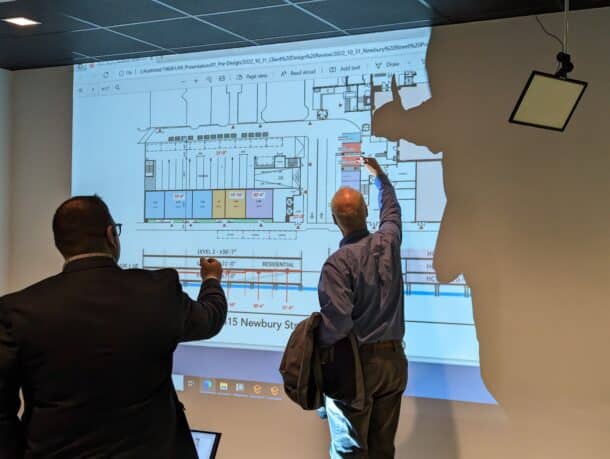
CBT’s office architects and interior designers use multiple conference and huddle rooms with large-screen facilities to work and collaborate together. This type of group interaction is a primary reason for an employee to come to the office rather than work from home. (Image: CBT Architects)
When I asked about the general pace of software developments, coupled with learning new ways of mastering hybrid work modes, Fereshetian noted it’s a challenge. “It’s challenging for most employees to keep up with the learning cycle of new tools,” she says, “Their jobs are architecture interior design and urban design, not software learning. So my team’s role is to constantly review and keep up to date so we are effective and efficient with our technology use.”
To help employees with their mastery of software tools, CBT features robust, managed SaaS learning platforms. “We have two companies we work with that have on-demand training on digital tools like Rhino, Revit, and other software skills,” says Fereshetian. “They are available to all employees on demand for learning. In addition, we run weekly Digital Practice sessions where a member of our team, another CBT staff member, or a guest presents on a timely topic.”
It’s challenging for most employees to keep up with the learning cycle of new tools. Their jobs are architecture interior design and urban design, not software learning.
Internal workshops and open conversation scenarios are critical to the learning process, not just sitting through software classes. “We need to understand and discuss the process of how, why, and when to use them and share knowledge,” she adds.
CBT also has new assessment tools in the online learning platforms “so folks can evaluate their knowledge,” she adds. “There’s a full-time staff member to help employees take those assessments and create learning paths for them. We have found that applying these tools in everyday work is important to retaining that knowledge.”
Commitment to Improving Revit Skills
Fereshetian acknowledges that adopting new technology can only be successful if its users are proficient. User knowledge and skill with foundational industry software like Revit are not under-recognized factors in a firm’s financial performance. Proficiency must be better understood, but the architectural industry has yet to set standard measures or guides.
A recent Xpresso special feature titled “Average CAD/BIM skills are too low: Why they should be raised and how to conceptually assess them” explores the idea of proficiency measurement. The article explains a proposed conceptual yardstick for assessment that places skill levels into six groups on an alphabetical scale, with A being the lowest and Z the highest skill level assessment. Across this scale were six groups from Beginner to Advanced Expert (see image below).

Averaged — Production Efficiency by Skill Level Group. Click on image for larger view. (Image: Architosh / All rights reserved)
In looking and reading about this conceptual yardstick, Fereshetian felt that CBT, on average, fell between J and N on the scale—which corresponds to Intermediate to Advanced Intermediate users. “However, we have a lot of project managers who have no experience in Revit,” she adds. “If we included everybody, we would have a different range (rating), but a fairer assessment should be in the context of people who need to know Revit.”
From a hiring proficiency point of view, she adds, “In that context, there should be nobody who doesn’t have experience. If you are allocated to use Revit, then you should be in the J-N stage.”

Averaged — Production Efficiency by Skill Level Group. When asking firms like BIG (Bjark Ingels Group), CBT Architects and multiple other firms in recent Architosh interviews and discussions, digital practice leadership says the average skill level of their BIM/CAD users tends to be in the “green zone”, as shown in the diagram above. This is an Intermediate to early Advanced Intermediate range. Nirva Fereshetian believes those hired in the practice who are expected to work in Revit must be in the J-N stage of skill development. (see our Analysis section at the end of this article for our thoughts on this — published in Xpresso No 50.) Click on image for larger view. (Image: Architosh / All rights reserved)
Fereshetian tells me that while the firm average fits where most firms will “self-assess” with this scale, the company is pushing to advance skills at the higher end of the spectrum. “For the past year and a half, the design technology team has had a great push in computational design technologies,” she adds, “and we are trying to move as fast as we can in terms of awareness in the firm so that if you are doing something repetitively, you need to connect with a Digital Practice team member and be sure to ask the question: is there a better way of doing this, how can we automate this task? Even as simple as encouraging you to use a myriad of plugins we have for Revit like Ideate.” Fereshetian would like to expand this group because every automation created is a win for saving time and, more importantly, changing the thought process.
The Economics of Technology
With newfound gains in efficiencies like computational design and automation, I asked Fereshetian how the firm evaluates the economic benefits of digital technologies. “Moving forward, as we develop these efficiencies, we have to put numbers to these efforts to know that these changes are helping across the board.”
She notes that developing the KPIs (key performance indicators) for various technologies is a huge challenge. “We have a system that once you file one of the emails, the system recognizes the chain and files all subsequent emails in the chain to the correct place,” she says. “It creates time savings on a project management basis, but how we define the KPI for this is a challenging concept to put into place.”
In that context, there should be nobody who doesn’t have experience. If you are allocated to use Revit, then you should be in the J-N stage.
Fereshetian recognizes that some digital technologies in architectural practice are straightforward to measure, and others are quite tricky, if not impossible. “All we can do is have some basic efficiencies and additional numbers for certain clusters of what we are doing.” Then there are the intangibles, she notes. She tells me how their media rooms with VR and AR technology excite clients and have led some clients to bring them more projects. “So, how can I capture that?”
Evaluating New Technology
While developing KPIs can be challenging for Fereshetian and her team, technology evaluation is one area where they have a more confident set of processes.
“We look very carefully before we test something,” she says. We ask, what is the goal? Is it making something better? Is it making something cheaper? Is it saving time? It has to qualify for at least one of those things even to have us consider it for testing.”
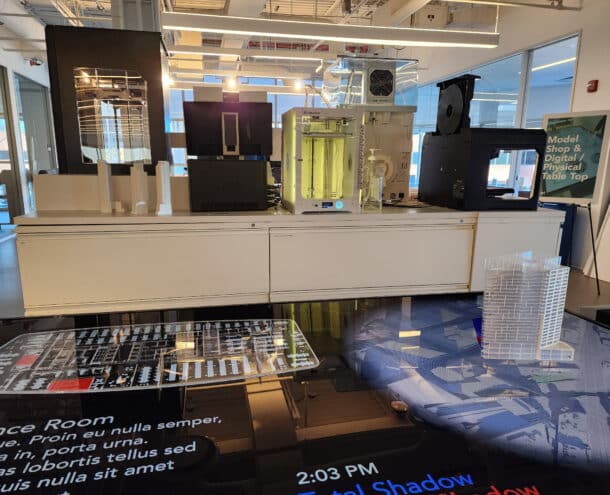
An image of CBT’s new Boston office showing just a section of its dedicated model shop area with an array of 3D printers the model makers use to build physical models that are then positioned over a large digital interactive display (in the foreground of the image). See the next image below. (Image: CBT Architects)
Having said that, she clarifies that getting new technology and tools into CBT is possible if the firm sees value in the technology. CBT has worked with dozens of industry startups trying to disrupt the existing ecosystem. The firm worked with Spacemaker back in 2018 prior to and through its acquisition by Autodesk and then with the Autodesk team, helping through the launch of Forma.
“Our design technology team first tests the product, and we can reject it right there,” she notes. “But if we see some value, the most important thing to do is put it into the hands of our project teams to check the value proposition.” Multiple designers and projects used Spacemaker (and subsequently Forma) before fully adopting the software. The firm was also one of the first few customers at Testfit, another startup aimed at disrupting the status quo.
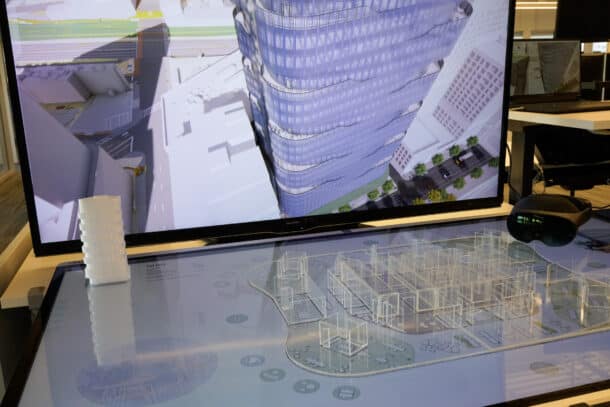
As part of CBT’s “immersive technologies,” the model shop’s output can integrate with a large flat interactive display where upon acrylic and plastic models can sit at scale and integrate with various interactive digital studies. When I was in the office, Nirva showed me shadow studies and how they work. The shadows appear on the screen as if the physical models are actually casting them. (Image: CBT Architects)
Fereshetian sees CBT as an incubator partner for these technology startups and is willing to work closely with them if the value proposition makes sense. The list of companies she’s partnered with is very long, with many having been acquired and others with which the firm still works.
Fereshetian says they never look for how much money they could save the firm with a tool. “Tools are evaluated much more comprehensively than that,” she notes. And that’s how they should be. While software costs have skyrocketed, she continues, “We will look carefully at that factor, along with others, and what kind of ROI we are getting by adopting a new product.”
Another complex factor in adopting a new tool is how it may relate to a given ecosystem. “Products are no longer standalone in the sense that today products function within an ecosystem or platform.”
BIM and the Autodesk Ecosystem
Fereshetian says that the Autodesk ecosystem is a complicated technology she and her team constantly evaluate. For example, Enscape has been in the firm’s hands for a very long time, and years ago, they had a dedicated rendering team that has given way to the democratizing effect of tools like Enscape. “But when a tool like Twinmotion comes in,” she adds, “the first thing we look at is what the product does differently than what we currently have and start educating our users about the differences.”

A rendered image of CBT’s new 380 Stuart Street tower building design. Rendering technologies have been highly democratized in the world of architecture and so CBT no longer has a dedicated high-end rendering team. Instead, more architects engage in visualization using interactive real-time rendering tools of choice like Enscape and Twinmotion. (Image: CBT Architects)
“We have also been a client of Twinmotion since it was Twinmotion (pre-Epic Games), and now it is being added to Revit in the next version. We have encouraged certain workflows, but it is not in everybody’s hands yet, but it will be in Revit 2023 and later,” Fereshetian explains.
When it comes to BIM, Fereshetian continues, “I think it is tough to talk about BIM without talking about Revit, so that right there is an issue.” While she knows that Revit may evolve and there are other tools like Autodesk Forma, at the moment, they use BIM 360/Construction Cloud on one hundred percent of all of their projects, further embedding the firm in the Autodesk workflow.
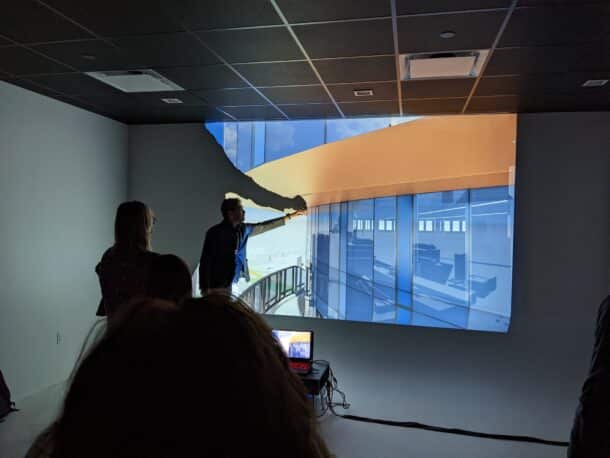
Using such visualization technologies as part of the design process greatly enhances CBT’s decision-making and problem-solving processes. Using the Media Room means problems can be solved at scale using high-fidelity color, lighting, and shadowing attributes. (Image: CBT Architects)
She brings up the differences between adoption and technology achievement when I bring up other tools, IFC, and interoperable effects of NVIDIA’s Omniverse and OpenUSD. “I see BIM 360/Construction Cloud as more of a collaboration tool, and we see more of our consultants working with us on that platform,” Fereshetian notes. “This makes the discussion of options an extremely challenging decision because it is no longer just us making a decision; the entire ecosystem has to move.”
I think it is tough to talk about BIM without talking about Revit, so that right there is an issue.
“So unlike other tools—and I think, progressively, everything is platform-based now—it will become harder and harder to say we will replace one tool with another because the decision becomes entirely dependent on the ecosystem to move together.” The sheer influence of the Autodesk ecosystem also complicates third-party tool adoption. “Autodesk recently purchased the content management system Unify,” says Fereshetian. “CBT already has a content management system in Avail. How do we then consolidate all of this?”
Autodesk is famous in the AEC industry for acquiring more digital tools than it develops in-house. Fereshetian points out that firms like CBT can invest in independent tools that work well to boost Autodesk’s ecosystem. However, if they become highly successful standouts, one of two things can happen. At first, they may become acquired, which sounds like wonderful news, or they may be competed against because Autodesk builds that tool’s features into a core product or acquires a rival with the same integration or intentions. The last example is the case of Avail at CBT.
“It makes us a bit concerned because every time we invest in using a product, it may eventually become an Autodesk product or feature,” she adds. “The promises of integrations tend to take longer than promised or sometimes don’t come at all.”
AI and Architecture
As for the promises of AI in architecture, Fereshetian feels that AI is the current trending topic and a powerful transformative technology that will change the way we live and work. “We need to research and plan for best approaches for our practices,” she says. “Currently, there is a lot of noise and hype to filter through.”
“I know that the ChatGPTs, DALL-Es, and Midjourney are creating front-end excitement, but it is not just image generation or ideation,” she says. “AI will be embedded in every process, every department, everything we do with real outcomes. It has tremendous potential and tremendous risk.”

While photo-realistic visualization technologies have been democratized, AI technologies currently in development will dramatically change the nature of visualization in architecture. Yet, Nirva Fereshetian knows that the ChatGPT AI boom that began in 2023 is just the very tip of the artificial intelligence (AI) iceberg. The firm is looking at generative AI and other forms of AI inference technologies such as UpCodes to dramatically enhance practice workflows. (Image above is of CBT design for Kendall Square Parcel C03.) / (Image: CBT Architects)
Fereshetian tells me that Generative AI will be the next productivity frontier. Assisting in many repetitive tasks that architects do now so they can focus on design and problem-solving rather than “changing the door tags over and over,” referring to highly inefficient repetitive work inside BIM today. AI technologies already being explored at CBT include the ChatGPT-like interface at UpCodes, urban analytics with Giraffe, design analysis with Forma, TestFit, and Finch, and exploring similar innovators like Arcol and Snaptrude. “Some of these new entrants we have worked with for a few years,” she adds. “And we are exploring our current vendors for what they are doing with AI, like Adobe with Firefly and Microsoft with Co-pilot.”
Fereshetian also sees opportunities in third-party players to address things lacking in Revit today. “We are looking forward to working with Skema.AI and similar companies creating efficiencies in Revit, automating mundane tasks or checking standards,” she says. “Things like text-to-BIM, for example, are very real and can help address the challenge of consistently not using our standards,” she adds. “A lot of our daily challenges are that someone hasn’t followed the standards, and using these automated routes to tackle those challenges makes perfect sense.”
One example cited in our conversation was code automation checking. “Instead of manually checking the code, that is just a standard, rule-based algorithm that can be set up in Revit.” Fereshetian sees this kind of AI technology emerging as pop-ups inside BIM tools like Revit. “It will let you know of the consequences as you are making changes in real-time. Not analysis after the model is completed.”
AI will be embedded in every process, every department, everything we do with real outcomes. It has tremendous potential and tremendous risk.
At this point, AI at CBT is in assist mode, exploration, and beta testing. “AI and ML need good data, and I see that as the biggest challenge the industry has,” she adds. “Our data sets are in a multitude of platforms, some open, some closed, in a file-based structure such as RVT, PDF, or Excel…” “I know there are some good efforts to bring that to a common data platform, she says, “and the success of those ideas and efforts is crucial for effective use of AI in industry firms.” As an individual practice, I am not sure we have enough data to train the learning process.
CBT Leadership Embracing Technology
Architectural practice in the current decade is facing dramatic technical disruption. While the past decade saw multiple emerging technologies reach the market, they have yet to impact AEC, like the AI revolution we are now facing will surely do. At the same time, cultural and industry changes include knowledge capture as legions of Baby Boomers exit the US workforce and shortages of qualified architects.
Nirva Fereshetian’s leadership at CBT, digital practice innovations, and stewardship in essential areas showcase an acute awareness of the complexity of these challenges. The problems are more than purely technical. They include cultural-professional shifts.
It certainly is very exciting and challenging times. Artificial intelligence, spatial computing, and other new digital technologies will continue to drastically change in the next few years.
In today’s contemporary practices, Fereshetian says, “There are no more specialists who teach you how to do something in a specific role. It has to be a constant conversation because there is so much out there, and interested people are looking it up.”
And when it comes to looking it up today, that means engaging in AI tools like ChatGPT, which can produce errors in its results. “You have to figure out how to work with it,” she says while emphasizing that her team’s role is to organize and orchestrate the review of these myriad technologies and plan for specific outcomes that will change everything we do!
“It certainly is very exciting and challenging times,” Fereshetian notes. “Artificial intelligence, spatial computing, and other new digital technologies will continue to drastically change in the next few years. It is important to keep adapting and leveraging while having these key conversations internally and externally with our partners so we have seamless technology integrations.”
This is no easy task in a competitive market that recognizes that best-of-breed solutions come from divergent sources, and industry expertise is just as broad. “Extending these conversations with the startups, venture capital firms, and industry groups at large is critical as this transformation can only work if we are in it together, not just as individual practices with disparate data silos and workflows.”
Editor’s Notes
This special feature is part of a series by Architosh published over the next several years, highlighting leading-edge “digital practices” within large or significant architecture firms. The goal of features like this is educational. We seek to help all architectural practices improve their digital practices and policies, advancing firm employee practices, firm structure, firm management, and transformation of architectural firm workflows.
Unlike our Firm Profile stories, the emphasis is far less on the digital tools they use as part of their creative pipelines, but rather on higher level digital practice management thinking and the physical arrangement of their office(s). We hope you enjoyed this article.

